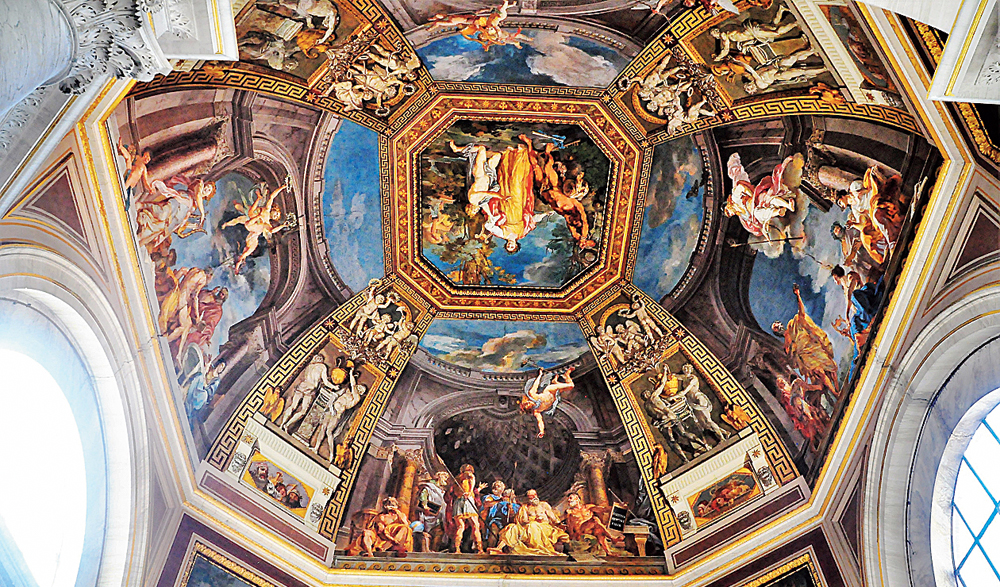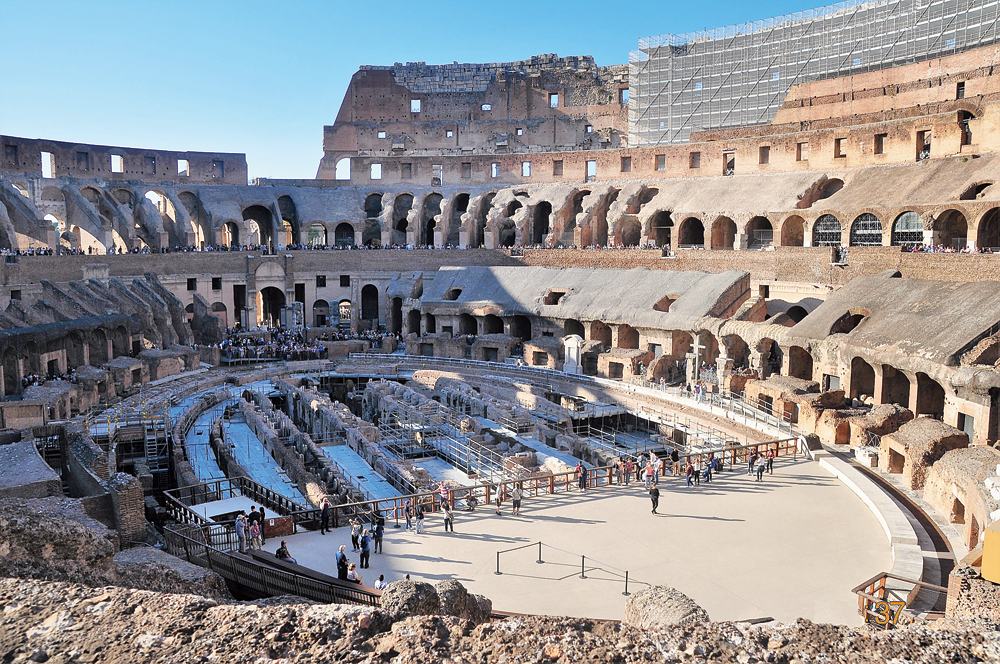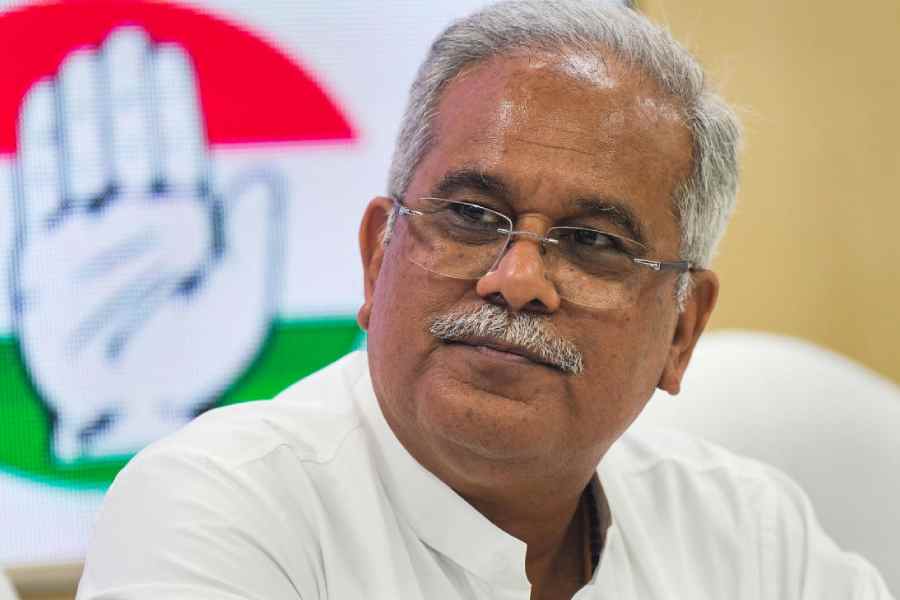What comes to the mind when you first think of Italy? Food, the Amalfi coast, or Rome with all its heritage? Or, perhaps, Florence with its vast treasures of architecture? But for me and my family, it is a tad different. We love road trips. And when you look for a driving holiday in Italy, you will be surprised at how many options there are for a road junkie. I did a bit of research, gave my daughter Radhika, a Class 11 student, a basic route, and asked her to draw up a plan for 16 days, excluding the time taken to get to Italy from Calcutta and back.
We had been to Rome and Venice when she was all of 11 months old, too small to appreciate anything about the places. As a person drawn to all things historical, she had never quite gotten over that. So, we unanimously zeroed in on Rome as our starting point.
Rome
We landed in Rome at 8.30 in the morning and took a Leonardo Express. A smooth, 35-minute journey later we were at Roma Termini, the hub of Rome and where we had booked our hotel.
It was early in the day and after a quick refresh, we were raring to explore the city. First stop was the majestic Colosseum. We had been here in 2004 but couldn’t enter it due to our cranky child and had to make do with clicking photographs from the perimeter.
Having figured out the map, we decided to walk to the site as that always gives a perfect experience of how any city moves and how its people are in general. Forty-five minutes later, we turned a corner to be greeted by the imposing structure standing in all its glory in the golden sunlight. A flood of memories gushed through my head and we stood dumbstruck for a long time.
As everywhere in Rome, people started converging on us, insisting that we take a guided tour at about 10 euros per person, apart from the entry fees. Having missed it on our earlier trip, we decided to go for it this time. It, definitely, was one of the best experiences of the trip.
After clicking a lot of photographs, quite obviously we met a very young, enterprising solo traveller named Ankur who was an automobile engineering student from Germany. He had submitted a project that won him a 1,000-euro first prize and here he was spending the loot! Having formed our own mini group, we proceeded to Palatine Hill, one of the seven hills in Rome, which is right opposite the Colosseum and is said to offer a fantastic view of the city from the viewpoint.
Since it was almost time for the sun to set, we were hoping for a spectacular sunset and the weather being crystal clear, this was surely a chance we had to take. In ancient Rome, this hill was considered one of the most desirable neighbourhoods and was the home of aristocrats and emperors. It was also believed to be the location of the Lupercal (the cave where Romulus and Remus were found by the she-wolf).
These associations with ancient legends and imperial power made the Palatine Hill one of the most important places in Rome. Today, it is an extensive archeological site, where the ruins of the Flavian Palace and Stadium of Domitian can still be seen, along with the legendary Hut of Romulus. The remains of the House of Augustus and the House of Livia have also recently been opened to the public, and are worth visiting for their amazing, well-preserved frescoes.
Museums
We had the opportunity of browsing through the immensely revered Vatican Museum with the Sistine Chapel, The Museo Nazionale Del Cinema in Turin, The Uffizi in Florence, The Teatro Alla Scala or La Scala opera house and museum in Milan and, of course, the Ferrari museum in Maranello.
The Sistine Chapel as well as the Vatican Museum are must-visits at least once in a lifetime, what with the detailing and the sheer audacity of Michelangelo combined with his sheer genius, it will make you gasp. More so when you see the level of detailing and try to imagine how, during those days, when there was nothing like what we see today in terms of technology, he managed to create what he did.
There are several anecdotes about how his paintings depicting nudes caused a huge stir in the Papal kingdom and how he finally got his way with them and also about how he did not paint the frescos lying down as is commonly believed when actually a platform was created so that he could stand upright and do so.

Painted ceiling in Vatican Museum
The National Museum of Cinema at Turin, on the other hand, is a cinema lover’s dream come true. We reached Turin on a very rainy day and, thank God, this was the only thing scheduled on our agenda. Housed inside Mole Antonelliana — it has a panoramic lift to give you breathtaking view of Turin, which we did not take considering the weather conditions — this museum has a spiral ramp that makes it easy for the visitors to climb gradually without breaking their knees and offers a delightful gamut of cinematic history from the first pinhole camera to the whole process of filmmaking to exhibits that are of legends such as Audrey Hepburn and Grace Kelly.
It boasts of a huge poster gallery which has larger-than-life versions of the most iconic posters you can dream of. While browsing starry-eyed through the several floors, I stumbled upon a photograph of a silent era Italian film actress who just looked like the doppelganger of my friend Swastika Mukherjee. The resemblance was so very striking that I had to post it on social media and that evoked a slew of very interesting comments from both her friends and family.
We spent a good five hours inside this museum, which even has The “Cinema” in the Temple Hall consisting of many chaise lounges from which visitors can watch excerpts from famous films, projected on four screens positioned in the hall corners.
Moving on to Florence, it caught us unawares during a session of tumultuous rain, which resulted in us getting completely drenched, but since our spirits were intact we managed to locate the Uffizi and even spent some time browsing the Duomo that is one the many Duomos all over Italy, each unique with the sculptures and inscriptions and some for the sheer size as well.

Pantheon, Rome
The Uffizi, as we all know, is famous for its collection of ancient sculptures and paintings of masters such as Botticelli, Michelangelo and Filippo Lippi, who are all from the famed Renaissance period of the 14th century. Consisting of two floors, the Medici family has contributed to this museum greatly through its collection of ancient busts and statues.
After marvelling at these works of art, I had to search for Saint Peter’s Chapel, which was nearby and hosting a concert titled The Four Seasons Air and Little Night Music by the Orchestra Da Camera Fiorentina. Upon reaching the ticket office and figuring out that the tickets were not outrageously priced, we settled down to enjoy what would be an unforgettable night of pure magic.
Vivaldi happens to be one of my favourite composers and his Four Seasons is always an uplifting piece of music. The setting inside the church was also stunning with ambient lighting and projector screens playing out images commensurate with the pieces being played. No words can actually describe the feelings one experiences while sitting in such a place.
The Ferrari museum actually has two versions, one at Maranello and the other at Modena, and while at Bologna I researched a bit to figure out that if one has a car then visiting the one in Maranello made better sense. Being a car and bike enthusiast and having had the opportunity to have driven across many cities in the world apart from taking part in car rallies, this was again one of the highlights of the trip.
Maranello, which is about 50km from Bologna, greeted us with the sight and sound of roaring cars with the famous prancing horse logos. It was a Sunday and there was an exhibition of some sorts being held by Ferrari. The museum itself is a masterclass on how to actually preserve, chronicle and showcase a brand which cannot be termed as a mere car manufacturer.

Dating back to 1935, from the earliest days of Scuderia Ferrari, when this race team set up by Enzo Ferrari used to race Alfa Romeos, to the latest road cars, you find everything that can possibly come to mind. The section that houses the trophies, the cars that won them, and the driver’s costumes with helmets gave us goosebumps throughout. Michael Schumacher’s helmet made me misty-eyed but he is sure to be back on his feet — the fighter that he is. Get well soon, Michael!
The La Scala or Teatro Alla Scala is an opera house at Milan, which has a museum that contains a collection of paintings, drafts, statues, costumes and other documents regarding La Scala’s and opera history in general. We were lucky to have been able to see behind-the-scene activities of an opera production from one of the luxury boxes above. The opulence of the hall is unmistakable as is the magnitude. Unfortunately, our timelines did not permit us to catch a live show there, which has to count as a low point of the trip. You do want to come back though for unfinished businesses, eh?
Food
The most important part of a trip to Italy would obviously have to be what else but food! However, being fitness enthusiasts and health conscious foodies, we had made up our minds to indulge in one heavy meal each day and keep the rest light. So a hearty breakfast was always our choice for the indulgence bit. We were floored by one particular item on the buffet in our hotel in Pisa which had a whole chunk of the beehive (minus the live bees of course) on the table from which you could strain honey and have it. Organic at that level!.
We were also obviously trying out the staple food of Italy — pizzas and pastas, and the one thing we did try every day was the gelato. In fact, we went to a store in Rome near the Spanish Steps that had 150 flavours, yes a hundred and fifty different flavours of ice cream on offer and was in the Guinness Book of World Records for this feat. Needless to say that we had a very tough time trying to decide which one to taste and could only manage about 12 odd flavours, all of which were terrific.
Another important ingredient we delved deep into in this trip were truffles — the ones Italians use as toppings for every conceivable food item. They are world class and we managed to bring a few bottles back.
Wines, as we all know, are also an intrinsic part of Italian culture and this trip took us to Montepulciano, which is famous across the world as the hub of red wines. The scenic and idyllic small town was as pretty as a picture postcard and the drive over these mountainous terrain was unforgettable.
Strewn with vineyards at every corner — we were directed to one named Manvi for a wine-tasting tour. Surprise of surprises, this small vineyard was owned by two Indians — Puru and Sudha, who are in their 50s and originally from Bangalore. They were bankers in Zurich before deciding to quit, follow their passion and did just that in 2015.
Producing 7,000 bottles every year, they have steadily become one of the most loved wines in Italy and their handmade wines are a testimony of what chasing dreams can actually result in. We tasted four of their popular wines. They produce only reds. And we brought back five bottles that cost us about 15 euros — not even Rs 1,000. Beat that!
Self-drive tips
- From January 2019, one isn’t allowed to drive in Europe without an international driving permit (IDP). So, you won’t be able to rent a self-drive car without it either.
- It’s cheaper to use a self-drive rental car than to fly or travel by train. Our Jeep Renegade cost us just Rs 1,700 a day, plus fuel. You can pick it up and drop it off at different cities. All major airports have the facility.
- Avoid picking up the car from the airport in busy cities. Do so when leaving town for other destinations.
- Carry a credit or debit card as highway tolls are mostly cashless and unmanned.
- Tank up in cities as petrol is 10 cents a litre cheaper than on the highway. Again, dispensers are unmanned. So, you have to be a little tech-savvy to fill your car up.
- If you aren’t on a data roaming pack (we were not) then download offline google maps on your phone as the car GPS may not be updated (our’s wasn’t) and you’ll lose time trying to reach your destination. No dadas will offer to help if you’re lost.
- Initially, it’s not easy to drive on the right and on extremely fast highways where everyone is very disciplined. I was always at speeds of
- 140-160kmph and never below 120kmph. So be careful but confident. The roundabouts could be confusing too as they follow a pattern of who will get an exit first. I have now figured it out.
- In cities, remember to give every right of way to pedestrians — you see one and stop. Simple.










